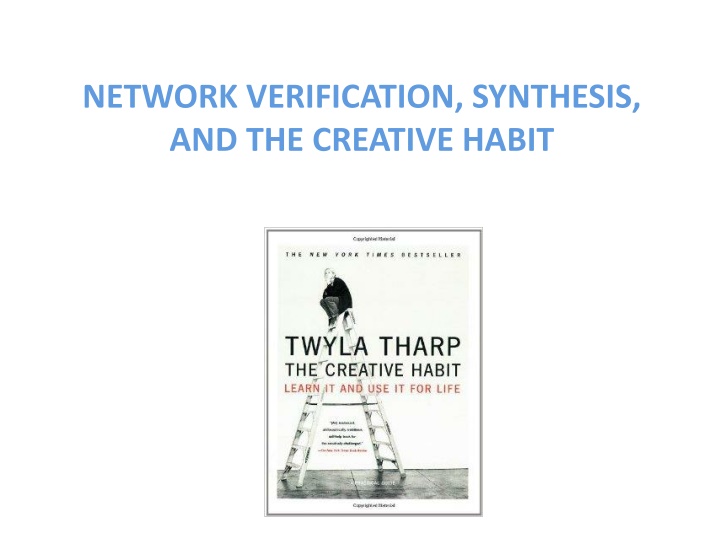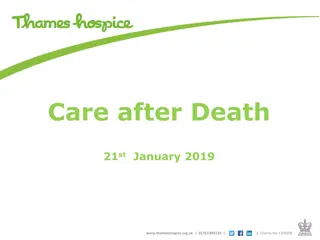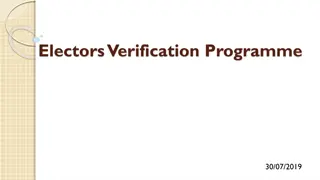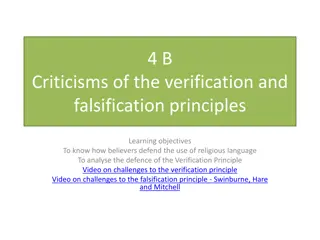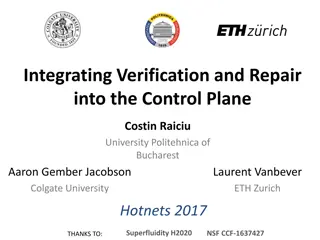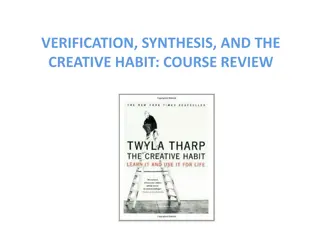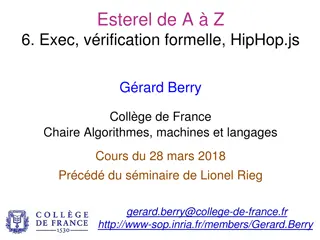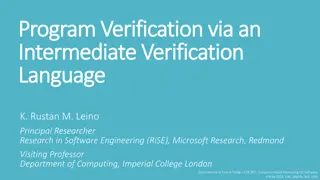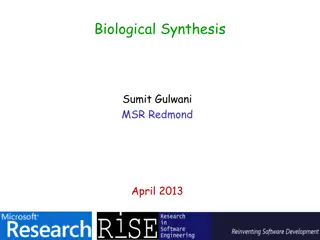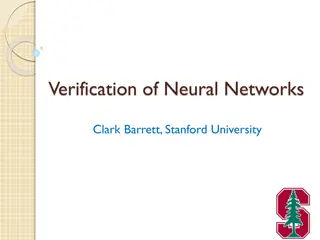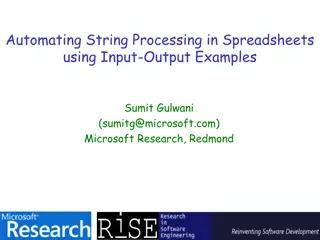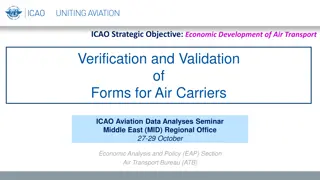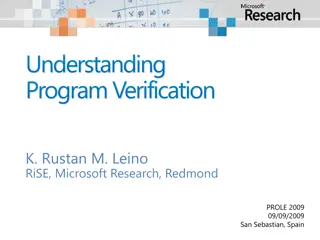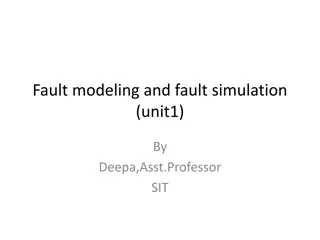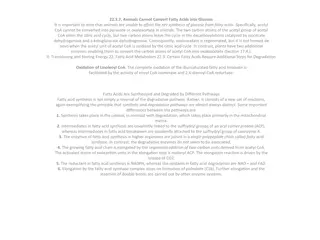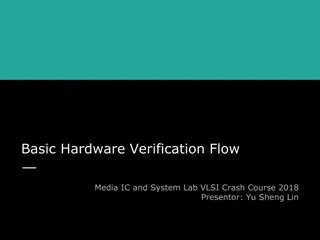Network Verification, Synthesis, and the Creative Habit
This course explores the interdisciplinary field of network verification & synthesis, introducing UCLA students to key ideas, terminology, and existing work. Dive into the state of networks today, configuration problems, and the impact of manual configurations on cloud failures. Featuring valuable insights and resources for attempting network verification tasks.
Download Presentation

Please find below an Image/Link to download the presentation.
The content on the website is provided AS IS for your information and personal use only. It may not be sold, licensed, or shared on other websites without obtaining consent from the author.If you encounter any issues during the download, it is possible that the publisher has removed the file from their server.
You are allowed to download the files provided on this website for personal or commercial use, subject to the condition that they are used lawfully. All files are the property of their respective owners.
The content on the website is provided AS IS for your information and personal use only. It may not be sold, licensed, or shared on other websites without obtaining consent from the author.
E N D
Presentation Transcript
NETWORK VERIFICATION, SYNTHESIS, AND THE CREATIVE HABIT George Varghese 1
Networking Formal Methods FOR PUBLIC CLOUDS, PRIVATE CLOUDS, ENTERPRISE NETWORKS, ISPs, . . . TOOLS NETWORK VERIFICATION: WHEN HOARE MEETS CERF George Varghese (based on a tutorial with Nikolaj Bjorner of MSR) 2
Goals of Course Motivate: why this may be an important inter- disciplinary field that can have real impact Expose: UCLA students to verification ideas and terminology Survey: describe and put in context existing work in network verification & synthesis Inspire: resources available, lessons for you to attempt network verification tasks
Acknowledgments Slides borrowed from many sources, including Marco Canini, Nate Foster, Brighten Godfrey, Peyman Kazemian, Dejan Kostic, Sharad Malik, Nick McKeown, Mooly Sagiv, Ragunathan, Jennifer Rexford Apologies for missing any work related to network verification, please email it to me for inclusion in later version.
Motivation: State of Networks today P1 1001 SQL 10* P1 1* P2 ,P2 Drop SQL P2 Access Control Lists (ACLs) Load balancing Multiple Protocols: 6000 RFCs (MPLS, GRE . . .) Multiple Vendors: Broadcom, Arista, Cisco, . . . Manual Configurations: Additional arcane programs kept working by masters of complexity (Shenker) Crude tools: SNMP, NetFlow, TraceRoute, . . .
Configuration Problems Shortest Path D S Manual Configurations: Managers override default shortest paths for security, load balancing, and economic reasons Data Plane + Control Plane: Vendor-specific knobs in both Problem: Manually programming individual routers to implement global policy leads to cloud failures 7
Sample Configuration File (like assembler, often 2000 lines)
Why manual reasoning is hard: DP I POLICY Deny Any C UDP Internet and Compute can communicate Internet cannot send to controllers B Allow Any C Allow C Any D X E F H G DNS Services are now blocked! 9
But there is also a Control Plane Can reach 1.2 in 1 hop 1.2.* Accounting 1.2.* 1.2.* 1.2.* Can reach 1.2 in 2 hops 1.2.* Data Plane (DP): Collection of forwarding tables and logic that forward data packets, aka Forwarding Control Plane (CP): Program that takes failed links, load into account to build data plane, aka Routing
BGP Routing: Beyond shortest path Route1 (p, . .) Route2 (p, . .) LP = 80 LP = 120 Route Processing Policy Static Route For p Static Routes take precedence Then come local preferences at this router (higher wins) Then comes some form of path length And more . . .
Control versus Data Plane Verification Program types: ????????????: ?????? ??? ???????????? ?????????: ???????????? ?????? ????????? Data Plane verification for fixed Forwarding Table ? : ??????: ( ,????????? ?, ) Control plane verification for configuration ? ?, : ( ,?????????(????????????(?,?), )))
Errors manifest as Latent Bugs Core C via up C via up Static Route: C via M B2 B1 C via up C via M management network Data Center Network M Buggy static route causes B1 to propagate wrong route to C. Works fine till . . . Specification: ? routing messages received PropagatedRoute (B1, e) = PropagatedRoute (B2, e)
Simple questions hard to answer today Which packets from A can reach B? Is Group X provably isolated from Group Y? Is the network causing poor performance or the server? Are QoS settings to blame? Why is my backbone utilization poor? Is my load balancer distributing evenly? Where are there mysterious packet losses?
Motivation to do better Internal: > 1 hr customer visible outage/quarter (P. Patel) Azure: 30,000 cores down 3 hrs, L2/L3 configuration bug Bing: Entire data center, 8 hours, L2/L3 configuration bug External: (2012 NANOG Network Operator Survey): 35% > 25 tickets per month, > 1 hour to resolve Amazon, BigDaddy, United Failures (NetCore paper) Welsh: vast majority of Google production failures due to bugs in configuration settings As we migrate to services ($100B public cloud market), network failure a debilitating cost.
Networks Tomorrow Online services latency, cost sensitive Merchant Silicon Build your own router Rise of Data centers Software defined Networks (SDNs) Custom networks Program custom design routing P4 (next generation SDN) redefine hardware forwarding at runtime Opportunity to custom design networks to optimize goal. Potential simplifications but hard to get right
Habits to Enable Creativity Motivation: > How to get my Ph.D.? Most courses about analyzing other people s work How do I come up with my own ideas? Some of her Habits: Rituals of Preparation Know your creative DNA Scratching Find a Spone While Twyla is about art, I would like to see if we can apply her ideas to computer science research. We ll add her ideas for a few minutes to some lectures
Digital Hardware Design as Inspiration? Specification Specification Testbench & Vectors Functional Description (RTL) Policy Language, Semantics Testing Functional Verification Logical Synthesis Verification Synthesis Static Timing Performance verification? Network Topology Design Static checking (local checks) Place & Route Design Rule Checking (DRC) Layout vs Schematic (LVS) Parasitic Extraction Wiring Checkers Manufacture & Validate Dynamic checkers/ debuggers Interference estimation? Electronic Design Automation (McKeown SIGCOMM 2012) Network Design Automation (NDA)?
This Courses Slice of NDA Specification Policy Language, Semantics Testing Verification Synthesis Won t discuss debugging, very little of run-time verification. Mostly interested in where formal methods can help
This Courses Slice of NDA Specification CTL, NoD, Klee Assert Policy Language, Semantics NetKAT, NetCore NICE, ATPG Testing Data Plane: Anteater, VeriFlow, HSA, Atomic Predicates, Cellular Verification, local checks Control Plane: BatFish, ARC, ERA Verification (e.g. reachabilty) Synthesis (e.g. forwarding) One big switch, NetCore, Propane Won t discuss debugging, very little of run-time verification. Mostly interested in where formal methods can help
Course Road Map Introduction to Formal Methods Data Plane Verification Data Plane Synthesis Data Plane Testing Control Plane Verification Control Plane Synthesis
Course Administration Will start by giving some intro lectures (introduction to formal verification, etc) You guys will be assigned papers each week and we will discuss each week (10 percent) One midterm (30), one final (30), one project (30)
Data Plane Verification Papers [Kazemian 12] Header Space Analysis: NSDI 2012 [Kazemian 13] Real Time Network Policy Checking Using Header Space Analysis. NSDI 2013 [Dobrescu 14] Network Dataplane Verification. Dobrescu, Argyraki. NSDI 2014.. [Jayaraman 15] Automated Analysis and Debugging of Network Connectivity Policies. Jayaraman, Bjorner, Outhred, Kaufman [Yang 15] Real time Verification using Atomic Predicates [Yuanjie] Cellular Verification [Plotkin 15] Scaling Network Verification using Symmetry and Surgery. Plotkin et al, POPL 2016
Control Plane Verification [Feamster 05] Detecting BGP Configuration Faults with Static Analysis. Feamster, Balakrishnan. NSDI 2005 [Fogel 15] A General Approach to Network Configuration Analysis, Fogel, Fung, Pedrosa, Walraed-Sullivan, Govindan, Mahajan, Millstein. NSDI 15. [Jacobson 16[Fast Control Plane Analysis Using an Abstract Representation, Gember-Jacobson, Aaron and Viswanathan, Raajay and Akella, Aditya and Mahajan, Ratul, SIGCOMM 16
Synthesis/Compilation Papers [Kang 13] One Big Switch Abstraction in Software-Defined Networks, Kang, Liu, Rexford, Walker. CoNEXT 2013 [Guha 13] Machine-Verified Network Controllers Guha, Reitblatt, Foster. PLDI 2013. [Jose 15] Compiling P4 Programs, Jose, Yan, Varghese, McKeown. NSDI 2015 [Beckett 16]. Don t Mind the Gap: Bridging Network-wide Objectives and Device-level Configurations}, Becket at al, SIGCOMM 2016 Conference
Testing Papers [Canini 12] A NICE Way to Test OpenFlow Applications, Canini, Venzano, Pere ni, Kosti , Rexford. NSDI 12. [Zeng 12] Automatic test packet generation. Zeng, Kazemian, Varghese, McKeown CoNEXT 2012 [Fayaz 15] From Header Space to Control Space: Towards Comprehensive Control Plane Verification, Fayaz, Fogel, Mahajan, Millstein, Sekar, Varghese, .
Introduction to Formal Methods Data Plane Verification Data Plane Testing Control Plane Verification Control Plane Synthesis INTRODUCTION TO FORMAL METHODS FOR NOVICES (POSTPONE TO LECTURE 2)
Verification: Values and Obstacles Hardware Software Networks Chips Devices (PC, phone) Service Bugs are: Burned into silicone Exploitable, workarounds Latent, Exposed Dealing with bugs: Costly recalls Online updates Live site incidents Obstacles to eradication: Design Complexity Code churn, legacy, false positives Topology, configuration churn Value proposition Cut time to market Safety/OS critical systems, Quality of code base Meet SLA, Utilize bandwidth, Enable richer policies
Main Idea: Network as a Program Model header as point in high dimensional space and all networking boxes as transformers of header space 3 1 Packet Forwarding 2 Match Action + + 0xx1..x1 11xx..0x Send to port 3 Rewrite with 1xx011..x1 Rewrite with 1x01xx..x1 Send to port 2 ROUTER ABSTRACTED AS SET OF GUARDED COMMANDS . . NETWORK BECOMES A PROGRAM CAN USE PL METHODS FOR VERIFICATION, TESTING, AND SYNTHESIS 32
Semantics Based Landscape (partial) Hoare style proofs (1960s-1980s): axioms, inference rules, invariants : scales poorly, hard for humans Model checking: search algorithmically over state space to check P. e.g., NuSMV, Impact, IC3 Proof Assistants: Humans help but system can check proofs. E.g., Coq, Isabelle. Testing: Symbolic execution to maximize coverage and check property failures (e.g., Klee, SAGE)
Ex: Approaches for Token Passing Program: Receive & Send Token Initially: s0 token is at A A Inductive Invariant I: Exactly 1 token at Node or Link (also correctness spec) Token Proof Assistant : Show each action maintains I Algorithmic Search: Want to show for all states reachable from s0 that there is exactly 1 Token in every state. Testing: Generate executions to exercise every action.
Pros and Cons Model checking: SMV, nuSMV, Impact, IC3 Pros: push-button verification ; Cons: finite state systems (e.g., fixed network). Hard to scale (needs abstraction, equivalencing, compression) Proof Assistants: Coq, Isabelle. Pros: Much harder work (must supply invariants) Cons: works for infinite state systems (e.g., all networks) and ideally needs methods to suggest invariants Testing: Pros: Can uncover bugs in large code without models Cons: Incomplete (state space too large), imprecise
To apply these techniques Need to have: Examples: a modelling language for networks state machines, Datalog, Propositional Logic a specification language for correctness CTL, Modal Logic, Datalog, a system, data structures to encode program and data and a solver NuSMV using BDDs for routers and packets
